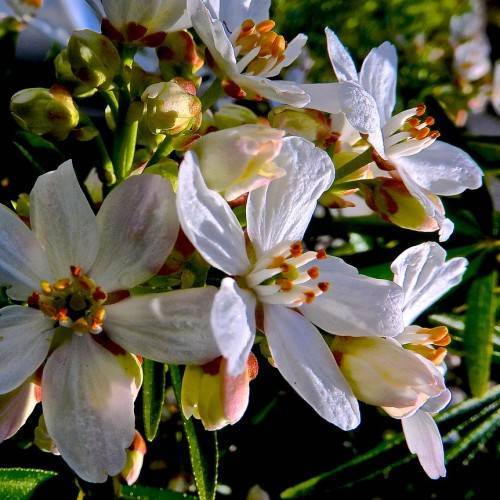
Mexican orange
Choisya ternata
Cycle:
Perennial
Watering:
Average
Hardiness Zone:
7 - 10
Flowers:
Flowers In Spring
Sun:
Part sun/part shade
Soil:
Acidic, Well-drained
Fruits:
Fruits In Autumn Ready In Fall
Edible:
Yes
Leaf:
Yes
Growth Rate:
Low
Maintenance:
Moderate
Salt Tolerant:
Yes
Thorny:
Yes
Care Level:
Medium
watering
It is important to water Mexican orange (Choisya ternata) plants regularly and deeply throughout the growing season. Watering should be done at intervals of approximately 1-2 times a week, although this may vary depending on the climate. In hotter areas, you may need to water more frequently while colder climates may need less water. When watering, it is important to make sure the entire root system is soaked thoroughly. To test soil moisture, poke your finger down about an inch into the soil. If the soil is dry, it is time to water. Water should be applied until it runs out of the drainage holes in the bottom of the pot or container.
sunlight
Mexican orange is a plant species that prefers full sun to partial shade exposure and should receive at least 4-6 hours of direct sunlight per day. For optimal results, the plant should receive full sun in the morning and partial shade in the afternoon. Mexican orange blooms from spring to summer, but the more sun it receives, the more flowers it can produce for a longer duration. Therefore, when conditions are favorable, Mexican orange should receive full sun from around 10am to 4pm. The total daily exposure should be 8-10 hours, depending on the plant’s location.
pruning
Pruning your Mexican orange shrub (Choisya ternata) is important for keeping it looking its best and promoting healthy growth. Pruning should be done twice a year, once in early spring (March) and again at the end of summer (August/September). The early spring pruning is the most important, as it helps shape the shrub’s growth and stimulates new flowering shoots. Cut away any dead or damaged buds and branches, and cut back any new shoots to control the shape and keep it looking neat and tidy. The summer pruning is mainly for tidying, as it’s best not to cut too much back as there’s still plenty of growth coming. Be careful not to over prune, the shrub’s health will suffer if you remove too much of the foliage.
